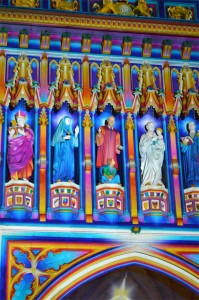
The blog has been a bit neglected over the past few months as the work level for my London Blue Badge course has ramped up, but once I’m through next month’s final course exams you’ll be hit with a superabundance of posts as I type up my notes on the British Museum, the Tower of London, St Paul’s – and Westminster Abbey.
One of the great things about doing the Blue Badge has been the opportunity to go around some of those London sites that tourists never miss, but which we Londoners rarely, if ever, visit.
Last week my fellow students and I were given the run of Westminster Abbey – the whole Abbey to ourselves, no tourists, no ropes or barriers; we were free to walk around and even take photos (although I’m not allowed to put any of them online). We even had a welcome and a talk from the Dean, the Reverend John Hall.
The reason that there is a charge for visiting the Abbey, he explained, is because they have no other regular source of significant funding – there’s no government grants, no Church money, no endowments – so the money paid by the 1.1 million visitors a year is what maintains the buildings and allows them to operate as a working church. (5,000 a week come to the services – and my top tip, if you want to see inside the Abbey for free and hear glorious music, is to go along to choral evensong, 5pm each weekday except Wednesdays.)
The entry to the Abbey is “extortionate” said Mr Hall, but has to be to keep numbers of visitors to manageable levels – too many and the pressure on the building and the maintenance required goes up. The amount charged is therefore to balance revenue against numbers. (And also to pitch it to be “less than the Tower, but more than St Paul’s”.)
It was my second visit to the Abbey in a matter of days as on the Sunday before I went to see the West Front lit up as part of the Lumiere Festival. Artist Patrice Warrener’s work ‘Light of the Spirit’ had painted the Abbey in light, particularly the statues of the 20th century martyrs. Not only was this beautiful in itself, it was also an echo of medieval times, when the insides of churches would be painted – walls, columns and statues. It’s only post-reformation and 17th century iconoclasm that we’ve come to regard austere stone as normal.


